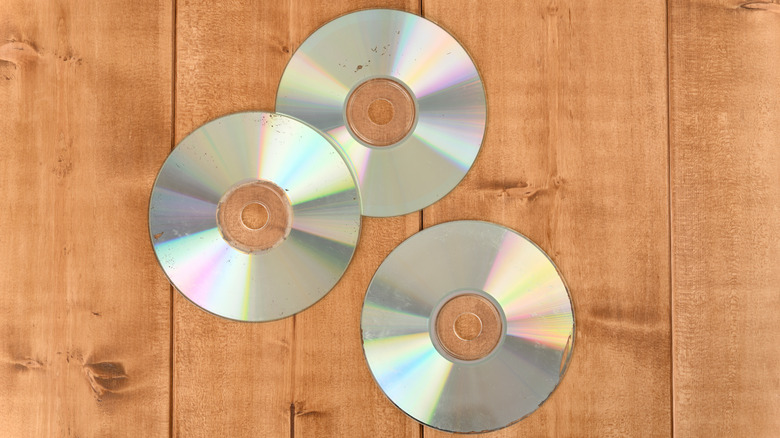How To Fix A Scratched DVD Or CD (3 Different Ways)
We may receive a commission on purchases made from links.
While physical media isn't as popular as it once was, most people own at least a few discs, whether they're old music CDs they grew up loving or a DVD of a movie that never made the jump to Blu-Ray. Unlike digital media, physical discs require care to keep playing for as long as possible. If your disc gets scratched, it might no longer play. It is possible to rescue a disc from the brink, however, so long as the scratch isn't on the label side (in which case it can't be saved). If your physical media has problems loading or begins skipping, it may be time to clean or repair the disc.
The first and most important step is to make sure the disc is actually what's causing the issue. The easiest way to do this is to try it with a different disc reader, like a game console. If it works okay there, the device you're using to play the disc may be the problem. Next, you'll want to clean the disc thoroughly. It may not be scratches, but rather dirt and grime making it act up. Get some dish soap or rubbing alcohol, put a little on a microfiber cloth, and rub it in circles on the disc, especially on greasy fingerprints. Then, rinse the disc with cold water, only touching the edges. Finally, use a dry microfiber cloth to dry off excess water. This may get the disc running again.
How to fix a scratched CD or DVD with household products
If cleaning the dirt and smudges off the disc didn't help, you can also try using a number of household products to buff any scratches out of the disc. The most popular option is plain toothpaste. Make sure it's just toothpaste with no particulates or harsh chemicals. Rub the toothpaste around the disc in circles with your finger, then rinse with cold water and dry with a microfiber cloth. Toothpaste is mildly abrasive, which is how it cleans your teeth. It may reduce or even remove the presence of scratches and improve playback.
If you don't have toothpaste handy, there are a few other options you can use instead. Some people use carnauba car wax or petroleum jelly to attempt to fill in the scratches. They're applied similarly to toothpaste — that is, rubbed on the disc in circular motions. Instead of rinsing, though, just use a microfiber cloth to wipe up any excess jelly or wax. If you're really in a pinch, some people swear by using bananas to fill in scratches on a disc. Peel a banana, cut it in half, and use the flat part of the banana on the scratches as you would an eraser on a pencil. Clean the disc with soap or alcohol to make sure it's not sticky. Dry with a microfiber cloth.
How to use a repair machine to fix scratched CDs and DVDs
Resurfacing discs is largely a last-ditch effort and can be harmful to the disc if done improperly, but it is the next step if buffing by hand doesn't fix the problem. There are some DIY repair machines you can find online under a number of brand names. Two popular ones are the Aleratec Disc Repair Plus with 3.9 stars out of 5 on Amazon and the SkipDr with 3.7 stars. Both work similarly, buffing the entire disc and not just the scratched area.
Some disc-repairing devices are electric and automate the process, while others like the SkipDr require the user to crank the machine manually. Generally speaking, these devices require you to insert the disc, apply a polishing paste, and then turn on the machine or crank the handle. These devices also leave a cloudy, circular pattern on the discs, which may be unsightly if you display your collection. Keep in mind that while this kind of resurfacing does work for some kinds of damage, these won't perform miracles, which is likely why they only have so-so reviews.
Send your scratched CDs and DVDs to a repair service
If your attempts to buff out the scratches by hand didn't work or you don't feel comfortable using a DIY repair machine yourself, there is one more option: professional disc repair services. In a great many cases, you can take discs to a local secondhand media store, and they'll resurface the disc using a machine for a small cost. The biggest downside, cost aside, is that the availability of this service may vary, as discs in general aren't as popular as they used to be.
This method also depends a lot on how much you trust the employees of the store. Try to stick to a reputable place that makes its money selling secondhand CDs, video games, movies, or any other discs, as these are the places that probably have a lot of experience fixing stubborn discs. The upside is that these stores may have higher-quality resurfacing machines than what you can buy for home use, meaning the final product may be of higher quality than going the DIY route.



